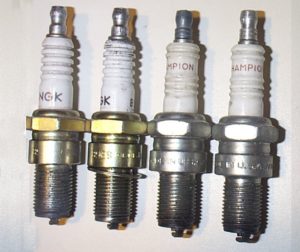Spark plug discolorations after a run are an accumulative indication of engine temperature. The spark plug plating discolorations after a run indicate the portion of the spark plug that experienced higher temperature somewhere on that run. Spark plug readings are most effective when a strong baseline is developed. If spark plugs are not discolored after a run, then either the engine is too rich or way too lean. Excess fuel will cool the engine if it is too rich. Not enough heat in the engine can occur for extreme leanness as well. Both of these can provide the same wet plug reading but with a different tuning need.
When developing a new setup without a good baseline, reading the spark plug color can be misleading. We saw many tuners with new setups who were lost when they tried using only spark plug color as a tuning indicator. If spark plugs are reused for several runs, then heat indications may not be reliable at all, especially if tuning changes were done between those runs. When a good baseline is already established, location and amount of heat indications on the spark plugs can indicate tuning characteristics.
However, those indicators may occur at the beginning, middle, or end of the run. The only way to sort out the difference is to make launch-only test runs and read the plugs. Then make half-passes and read the plugs. Then make full-passes and read the plugs. This would indicate where the spark plug color is occurring. If spark plug heat indications appear in the test sequence, at least one new spark plug should be installed to examine the effect from the next sequence of testing.

Discoloration of threads on plated park plug indicate tuning characteristics. Plating from different suppliers discolors at different temperatures. Note thread color differences between NGK’s on the left and Champion’s on the right. The presence or absence of a spark plug washer affects the reading as well. Photo taken from “Fuel Injection Racing Secrets” by Bob Szabo.
Several brands of spark plugs are plated, however platings from different brands discolor at different temperatures. Heat indications from different brands may be dramatically different for a specific tune-up. For a new setup, sticking with a single brand may simplify tuning from more consistent heat indications. If the spark plug brand is changed, prior spark plug reading indicators may change. A different brand may look colder or hotter than the brand used to develop a baseline.
When the arc in a spark plug ignites, only the oxygen and fuel molecules go through the arc when it is firing. That is an extremely small percentage of the total molecules of oxygen and fuel to combust in the chamber. Combustion is further dependent on a flame front from subsequent oxygen and fuel burning throughout the cylinder. That flame front is completely dependent on the air/fuel ratio. A rich mixture slows down the flame front. A moderate rich to moderate lean mixture speeds up the flame front. An excessively lean mixture slows down the flame front. Rich or lean indications from spark plug readings alone can be confusing. A good air/fuel ratio baseline in addition to spark plug readings can ensure consistency in your setup.
